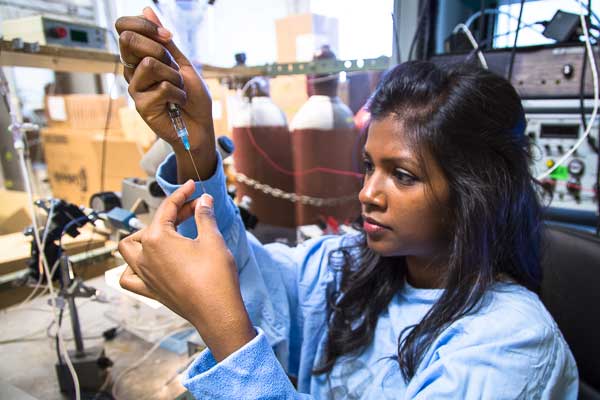
Unlocking the mysteries of hypoglycemic seizures
Published: October 4, 2013
It’s the part of our body that controls what we think, the ways we move and how our other organs function. Though we know the brain plays an important role in our day-to-day life, there’s still a lot to learn about how it works.
Sonia Sugumar is excited to help unlock those mysteries.
“I feel like it’s still one part of our human body that we have a very limited understanding of,” she says. “We still know relatively little about the brain compared to what we know about the rest of the body.”
Sugumar is completing a master’s degree in physiology through the University of Toronto’s Collaborative Program in Neuroscience, which includes graduate students from 15 departments in six faculties at U of T.
“[The program] really helps bring us all together,” says Dr. Peter L. Carlen, Sugumar’s supervisor, and a professor in the Faculty of Medicine’s Departments of Medicine (Neurology) and Physiology. “We’ve got an enormous reservoir of neuroscience talent across the university, and we need something to pull us together and this program does it.”
Carlen is also the senior scientist in the Division of Fundamental Neurobiology at Toronto Western Research Institute. His lab is the site of several research projects, including work on the cellular mechanisms and nervous system communications in epilepsy, exploring what happens during transition into seizure.
Sugumar is involved in another project within Carlen’s lab, and is exploring the ways low blood glucose levels can affect electrical activity within the brain to cause hypoglycemic seizures, which can be the result of an insulin overdose in people with diabetes.
Using mice, the lab is looking at the role of an artificial cerebral spinal fluid composition, which bathes the brain. The group is exploring the various components that make up this fluid and how they affect the brain.
In particular, Sugumar is adding to what is known about gap junctions, which are “bridges” between brain cells that allow the passage of electrical signals in the form of calcium or sodium ion movement, generated by small molecules like glucose. She’s zeroing in on how the absence or presence of these “bridges” can affect brain activity in the presence of very low blood glucose levels.
It’s an area that’s been well-studied in the context of other medical conditions such as epilepsy and ischemic stroke.
Sugumar is passionate about this field of study. She became interested in neuroscience during her undergraduate studies. A summer job at the National Research Council in Ottawa allowed her to gain valuable microscopy techniques that led her to Carlen’s lab.
“The aspect of just how much there is left to learn really drew me in to neuroscience,” says Sugumar.
With just a short time left before she completes her degree, Sugumar plans to publish her findings in the near future. She’s confident that what she’s researching today could become a building block for new developments long into the future.
“Even the smallest contribution can have the potential to make a huge difference.”
U of T Medicine’s Brain Health and Neuroscience Network spans nine hospitals, 250 scientists and includes $98-million in research funding. (Read more about the Network.)
Erin Howe is a writer with the Faculty of Medicine at the University of Toronto.



